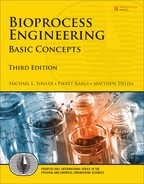Preface
This third edition of Bioprocess Engineering: Basic Concepts updates the prior two editions. Although the principles of bioprocess engineering stated in the first two editions remains sound, the field has made considerable advances in improving the productivity, consistency, and safety of bioprocesses.
Some of the major changes in the book come from biology itself with the development of tools that have greatly increased our ability to both understand and manipulate cell biology more effectively and cheaply. On the bioprocess side, tremendous advances have been made in production of biologicals with greater emphasis on processes incorporating animal cells. In particular, productivity in making many heterologous proteins has increased by several orders of magnitude over the last 16 years. The commercial use of animal cell culture has increased significantly over this period of time, and plant cell culture is starting to see commercial applications. Processes with microbes based on recombinant DNA and related technology have matured greatly. For any cell type, consistent authentic posttranslational processing of proteins remains challenging. The development of the concepts in systems and synthetic biology is now having an impact on the thinking of bioprocess engineers.
In this edition, we either introduce or expand discussion of the following issues:
• The role of small RNAs as regulators
• Cell-free processes
• Synthetic biology
• Role of genomics
• Development of single-use technology in bioprocesses
• Stem cell technology and utilization
• Use of techniques of microfabrication and nanobiotechnology as well as 3D printing
• Animal and plant cell biotechnology
• Development in environmental biotechnology
Teaching a subject as broad as bioprocess engineering in one semester is a difficult challenge, considering the range of backgrounds students may have. Although many engineering students have some formal exposure to specific areas of biology, they often have not had an opportunity to complete courses from several areas of biology. The biological concepts necessary for an engineer are described in Part 1, “The Basics of Biology: An Engineer’s Perspective.” Although this condensed treatment cannot replace an in-depth knowledge of biochemistry, genetics, microbiology, and cell biology, it serves as a useful starting point for a bioprocess professional. On the process side, an instructor might wish to emphasize Part 2, “Engineering Principles for Bioprocesses,” dealing with biopharmaceuticals, bioenergy, or waste treatment, as they decide which topics would be effective for their students.
We hope this book imparts the excitement of bioprocess engineering as well as the basic concepts and knowledge to become a leader in this field.
Acknowledgments
The development of this edition has been assisted by comments of many of our colleagues across the world. Although a full list is too long to include here, we would like to acknowledge some specific contributions:
Jeff Chalmers and Brian Pfleger served as technical editors for the book and provided many useful suggestions and corrections. Michael Thurston did yeoman’s work as development editor. Carolyn Lee-Parsons provided detailed input to Chapter 13 as well as extremely helpful suggestions on other chapters. Thomas Mansell and Jason Boock provided detailed input to Chapter 14. Others making significant contributions to various sections of the book include Kent Goklen, Itzcoatl Pla, Raymond Ketchum, Harrison Yoon, Taylor Stevenson, Jeff Varner, and Susan Roberts. Jason Haugh provided a number of homework problems to us. We would like to thank Dr. Serkan Eker of Dokuz Eylul University, Izmir, Turkey, for his expert services in drawing some of the figures in the book. We also acknowledge the excellent technical support provided by Brenda Stevens in the preparation of the manuscript for this book. In addition, many former students and colleagues have provided useful comments and suggestions. We thank them, as well as many of our other colleagues, for their comments and advice.
